Early Water Construction
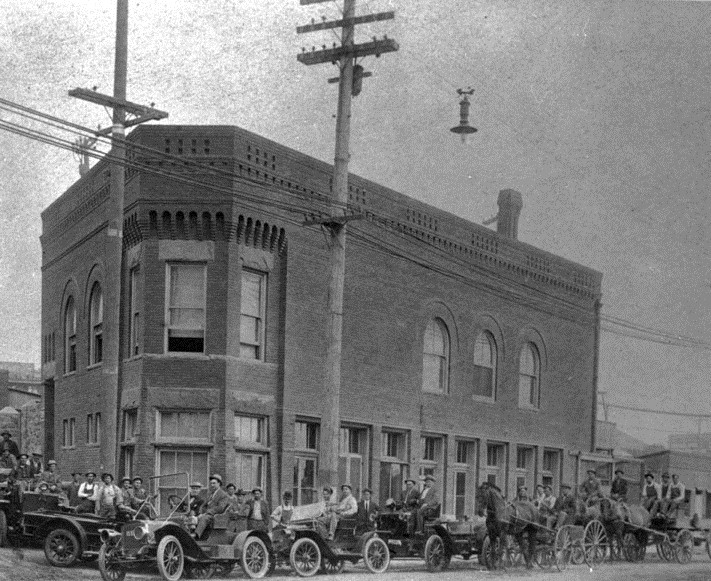 |
|
| (1912)* - Crews assembled in front of the original office building of the LA municipal Water Department. |
Historical Notes The original office of the Department came into its possession in 1902 as an inheritance, from the Los Angeles City Water Company at the time of the acquisition by the municipality of this privately owned water system. This relatively small but sturdy, two-story, brick structure, originally built to house a furniture factory, stood on the northwest corner of Alameda and Marchessault Streets. Click HERE to read more on the Water Department's Original Office Building.^ |
 |
|
| (1912)* - Bureau of Water Works and Supply^ forces pose for photographer at the Water Works Yard at 510 East Second Street (Second and Rose Streets). William Mulholland is seen behind the steering wheel in the center of the second row of cars. |
LADWP Historic Archive Demolition of the two-story westerly portion of the 510 East Second Street (Second and Rose Streets) facility and the removal of the complex of old sheds from the south and east perimeters of the property was completed in late 1965. The job started in July of 1965. The Water Department was renamed the Bureau of Water Works and Supply after the creation of a municipal department in charge of electricity, the Bureau of Power and Light, in 1911. The Los Angeles muncipal utility did not take on its final name, Department of Water and Power (DWP), until 1937 when the Bureau of Water Works and Supply consolidated with the Bureau of Power and Light. Click HERE for a chronology and explanation of all the DWP name changes. |
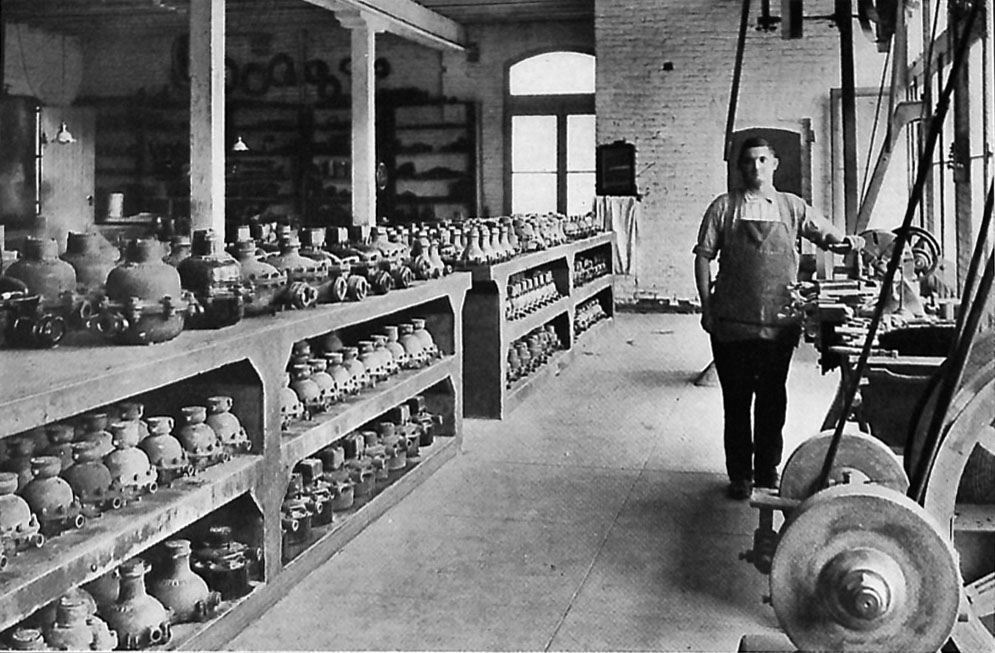 |
|
| (1911)^^ – Meter Repair Shop |
 |
|
| (1920s)* – Panoramic view showing the Water Yard at 2nd and Rose Streets. |
LADWP Historic Archive At Second and Rose there is a cramped but well-equipped machine shop and garage in charge of F. M. (Marion) Vandeventer. This machine shop and garage keeps in repair 412 motor vehicles, ranging from Ford roadsters to seven-ton trucks, the above-mentioned construction equipment, and other miscellaneous equipment. Also most of the repair work on the pumping plants is taken care of by this shop. Considerable original construction equipment is built in this shop, the latest achievement being a unique trench pump built on a motor truck; a centrifugal pump with a capacity of 800 gallons per minute is also directly connected to a seven and one-half horsepower motor driven by energy furnished by an automatically controlled generator on the body of the truck; the motor-pump unit being swung to position by a small swinging crane on the rear of the truck; the motor generator furnishing lights for night construction work. The headquarters for the division’s store department are located at Second and Rose Streets, in charge of Mr. L. R. Anderson. Automobile repair parts, small pipes, pipe fittings, groceries, and miscellaneous items are received, stored and issued at the Second and Rose Street Warehouse. The larger items, such as cast iron pipe, gate valves and large cast iron fittings, are handled at Ducommun Street, Enterprise Street and Slauson Avenue Yards. All construction camp mess supplies and miscellaneous items are received at Second and Rose and delivered to camp by warehouse trucks. Mr. Anderson has the supervision of a force of clerks who keep all accounts of material handled through the Second and Rose store department, except automobile repair parts and equipment. The transportation division with R. R. Bohmer as cost accountant handles all automobile material and equipment accounts and has in operation a very detailed and up-to-the-minute system for arriving at operating costs for all automobiles owned by the Bureau of Water Works and Supply. Demolition of the two-story westerly portion of the 510 East Second Street (Second and Rose Streets) facility and the removal of the complex of old sheds from the south and east perimeters of the property was completed in late 1965. The job started in July of 1965. Formerly occupied by the Photocopy Section at Second and Alameda Streets from 1936 until its transfer to the new General Office Building, the cleared area will be utilized for parking and outdoor material storage. A chain link fence will replace the brick walls surrounding the historic plot. The relatively ancient building was construction in 1912 for use by the Water System as a horse stable and feed loft. Hay was unloaded from railroad cars on the Alameda Street right-of-way into a centrally-located loft door about twelve feet above the pavement. After drayage mules and horses were replaced by the internal combustion engine, the building housed maintenance crews for several years. Later, it was used for storage purposes. According to Howard E. Norris, superintendent, Reproduction Services, the second floor of the old Photocopy Building served as a prime vantage point for viewing convention and circus parades which followed the Second Street route to Broadway from the Santa Fe Station. Norris also recalls that trains traveling along Alameda Street at 30 to 35 miles per hour caused enough vibration to disrupt intricate photocopy and reproduction work. Oldest structure in the System currently in use is located on the south boundary of the plot. It was constructed in 1903 as a combination blacksmith shop, machine shop, and offices. The headquarters of William Mulholland were formerly located on the north side of the upper floor. In 1932 a soil and concrete testing laboratory was installed in this building by Stephen E. Smith and Sterling Green who later became head of the laboratory. A protective coatings laboratory was added to the activities several years afterwards. An electrolysis section followed in 1935. Oscar N. Denman, superintendent, Materials Engineering and Test Laboratory, and his staff now occupy the 63-year-old building. First advertised for bids on an informal contract, the demolition job was re-advertised as a salvage bid and brought the Department a cash bonus from the successful wrecking company for the used brick and other salvageable material, according to Carl L. King, Structural design Section, Water Engineering Division.** |
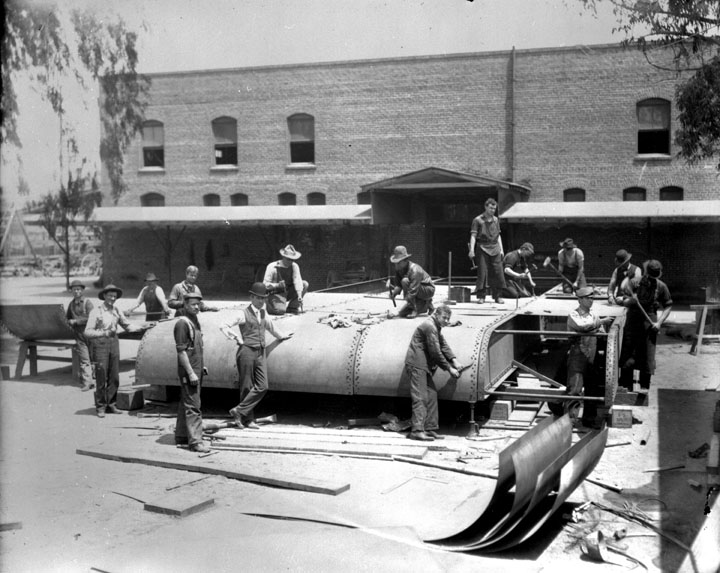 |
|
| (1920s)* – View showing a crew assembling some type of structure using sheets of metal at the Water Yard at 2nd and Rose Streets. |
 |
|
| (ca. 1920s)* - The Water Department's ditch digging equipment of the 1920's . |
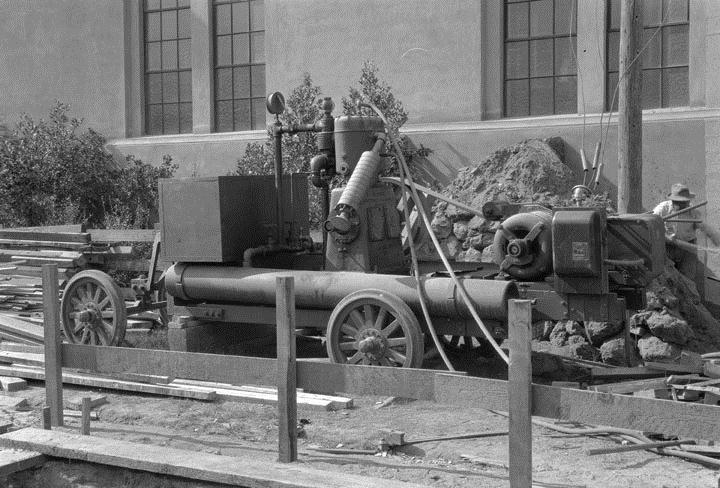 |
|
| (ca. 1920s)* - Early portable compressor used by Bureau of Water Works and Supply construction workers. |
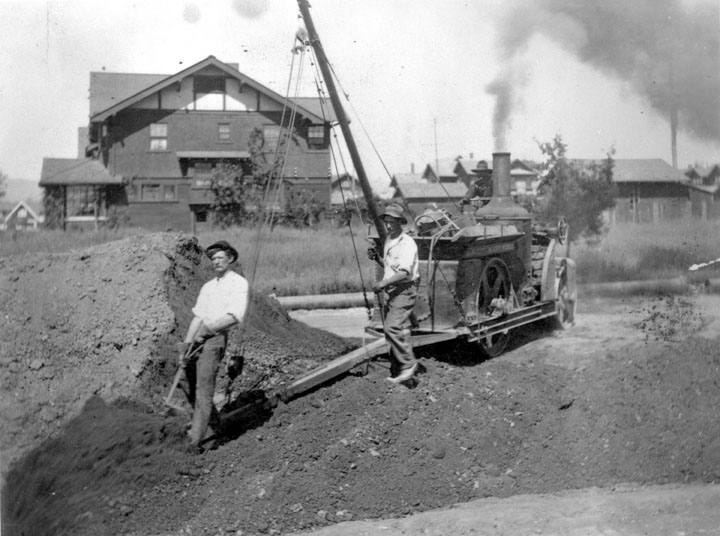 |
|
| (ca. 1920s)* - Early equipment used to backfill a trench. |
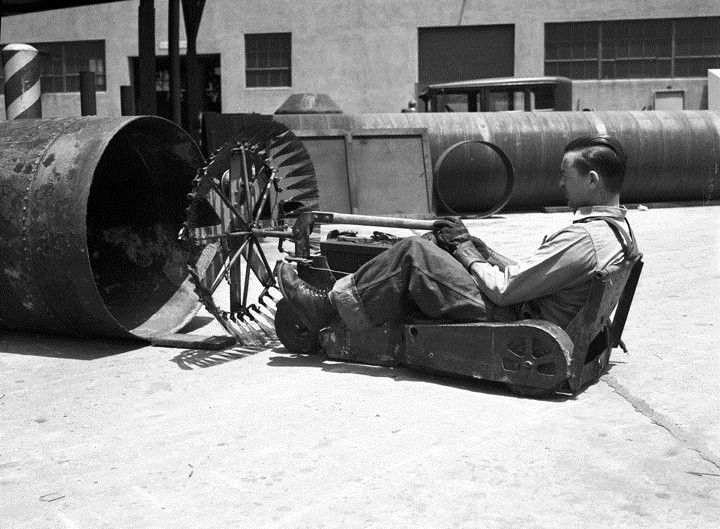 |
|
| (1936)* - Mechanical device, designed by DWP engineers, for detecting defective enamel coating in 30" water mains. |
December, 1936 - New Mechanical DWP Designed Device to Inspect Water Pipes Vehicular subways are now a reality in Los Angeles but only the municipal Water Bureau has access to the underground system. A specially built pipe perambulator is the vehicle that converts the 36-inch Stone Canyon truck line now under construction into a miniature subway. But the daily trips the unique car makes through the dark pipe interior is strictly Water Bureau business and never will be available to the motoring public. |
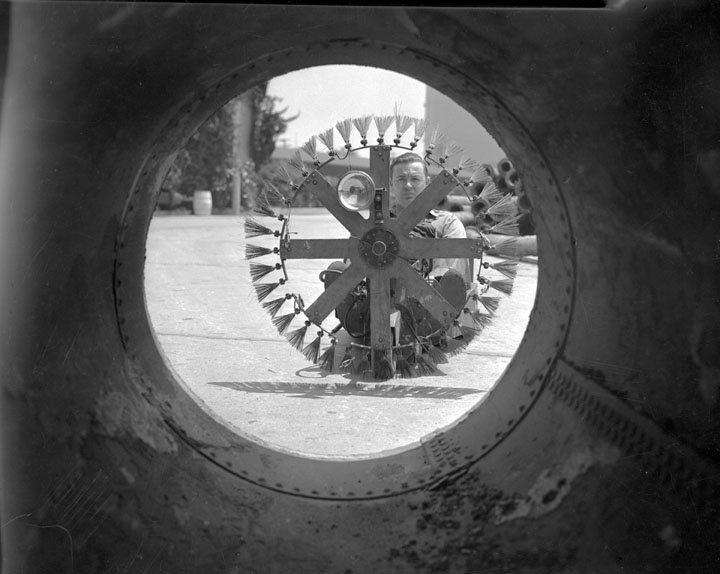 |
|
| (1936)* - Pipe’s-eye view of perambulator with William Goodwin in driver’s seat. |
LADWP Historic Archive The perambulator, more officially known as an inspector’s carriage, is used inside water mains to detect any insufficiencies in the protective enamel coating applied to steel pipes. An electrically charged circular steel brush establishes contact against the interior pipe surface, throwing off sparks when a bare or thinly covered spot is encountered. The machine can travel as fast as 20 miles an hour in its private subway system, although two to three miles is a normal speed when testing enamel coating. It has sufficient power from its batteries to pull two trailers with a total of three men. Another important use for Waite’s “wagon” is hauling enamel heated to 450 degrees to be applied to the pipe.** |
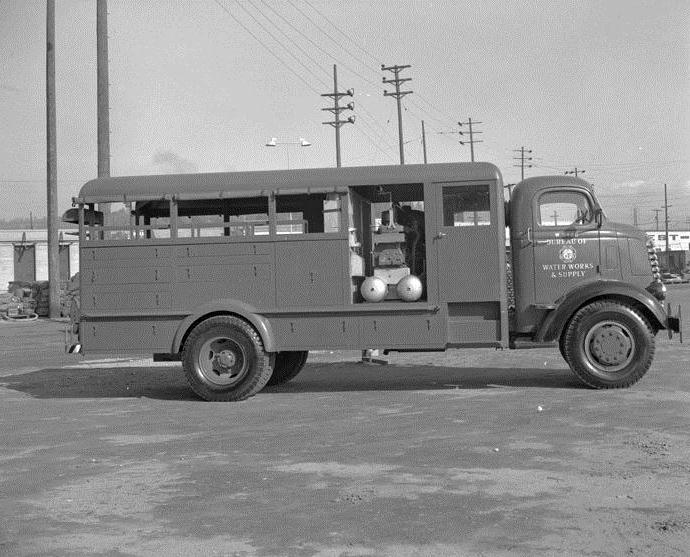 |
|
| (1942)* - Water Division field service truck used in the 1940s. |
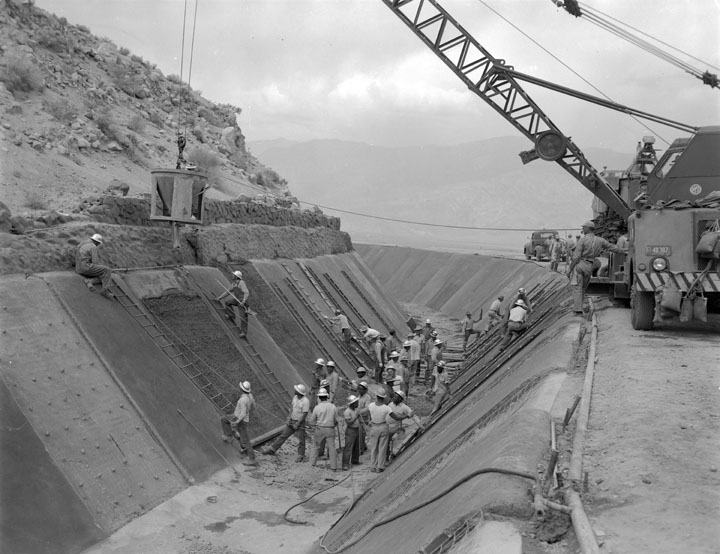 |
|
| (1951)* - Section of the Aqueduct being repaired. |
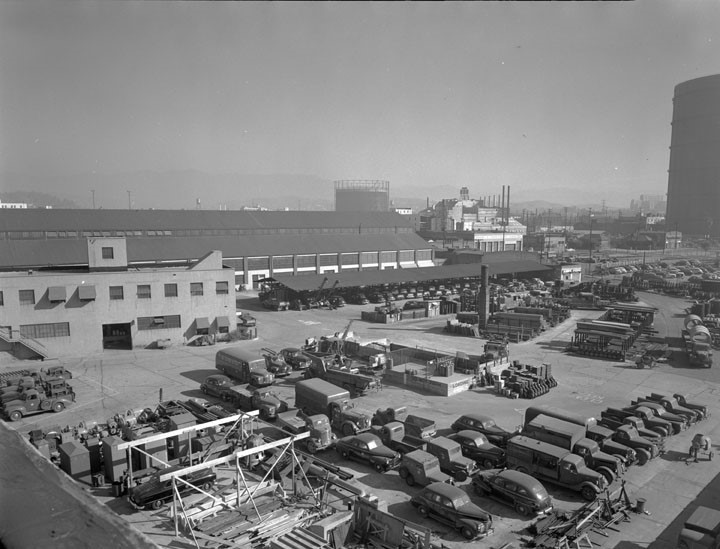 |
|
| (1951)* - Overall view of Water Yard at Ducommon Street. |
LADWP Historic Archive (1930) Concentrated at Ducommun Yards are an innumerable quantity of Water Bureau activities necessary to the efficient operation of the vast water system of Los Angeles. After considerable moving around and adjustments of materials and buildings, Ducommun now is occupying its big new yards More than three years ago (1927) street main activities were moved to Ducommun. This included the machine shops, water transportation, and meter service shops, pipe and salvage yards, etc. Requirements quickly grew quite beyond the space available. The Department negotiated for purchase of properties occupied by the Pioneer Truck Company. Originally Ducommun consisted of 5.13 acres. The acquirement of the new portion brought the total acreage to 7.88. This gives 400 feet frontage on Alameda, Jackson and varies on the other streets from 369.47 feet to 189 feet. Ducommun is a busy place. Locomotives shunt cars into the yards for delivery of pipe. Large cranes move about with their cargo of pipe to be stacked in neat tiers in the pipe yard or carried from the stacks to waiting trucks. The whirr of machinery is heard in the machine shop where expert mechanics work in metal fashioning materials for use by the Department, or repairing parts worn or broken is use. The buzz of the saw and the snap of the hammer may be heard in the carpenter shop which occupies one floor of the new building at the extreme side of the new portion of the yard. In this new structure also may be found the storeroom, various offices for personnel of sundry sections. Draftsmen, clerical forces and others who contribute their time and efforts to the carrying forward of Water Service, occupy other buildings in the Ducommun Yards.** |
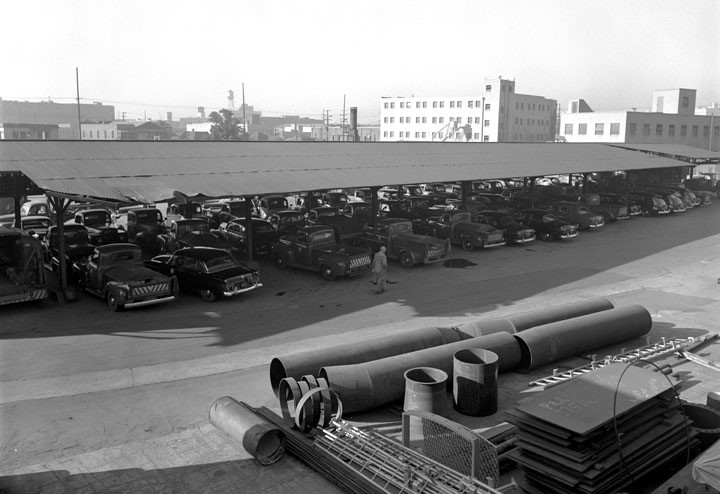 |
|
| (1953)* - Congested area of Water Yard at Ducommon Street. |
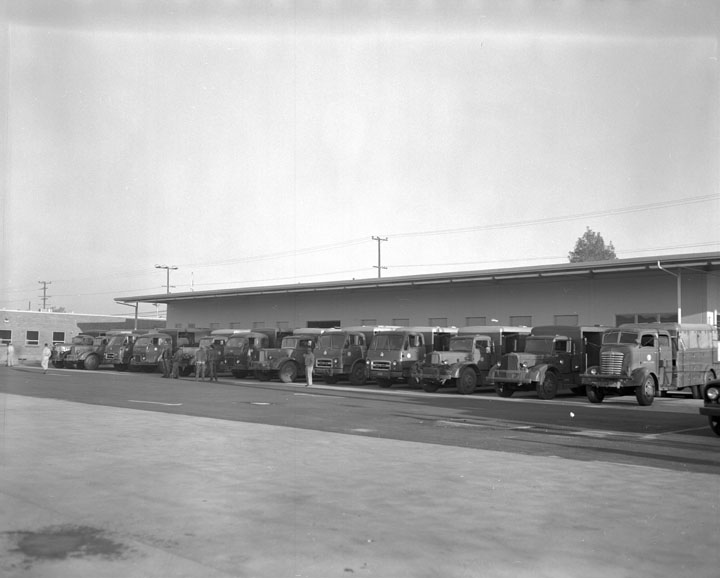 |
|
| (1958)* - Line up of trucks in new East Valley Water District Headquarters yard at Saticoy and Bellair. |
LADWP Historic Archive The booming growth of San Fernando Valley has been marked by award of a $929,442.50 contract on October 25, 1956 by the Board of Water and Power Commissioners for construction of an East Valley Headquarters for the Water System. |
References and Credits
* DWP - LA Public Library Image Archive
^^Annual Report of the Board of Public Service Commsioners - 1911
< Back
Menu
- Home
- Mission
- Museum
- Mulholland Service Award
- Major Efforts
- Board Officers and Directors
- Positions on Owens Valley and the City of Los Angeles Issues
- Legislative Positions on
Water Issues
- Legislative Positions on
Energy Issues
- Recent Newsletters
- Historical Op Ed Pieces
- Membership
- Contact Us
- Search Index